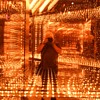Posted 9 years ago
 rniederman
rniederman
(346 items)
This lovely daguerreotype of a young lady is a nice example of the earliest form of stereo photography. Daguerreotypes are the first commercially successful type of photographic imagery and predominantly spanned 1839 to the mid-1850s. Each is a unique image and the majority are portraits. Even today, a technically fine daguerreotype has a tonal range and delicacy that is unrivaled by later processes, but challenges such as long exposures, bulky handling, toxic mercury chemistry, fragile images, and high costs compelled photographers to move to wet collodion technology as the 1850s progressed.
Stereo photography’s roots go back to 1841 when Henry Fox Talbot and Henry Collen were making pairs of photographs for viewing in Sir Charles Wheatstone’s stereoscope. By 1851, Sir David Brewster had invented a stereoscope that mimicked human vision.
At the time this stereo daguerreotype was made, stereo cameras (apparatus with two lenses) were just being invented. Yet because lenses in the 1850s were expensive, stereo cameras were expensive as well; therefore, alternative methods to produce stereo images were pursued such as designing a camera that slid on a base or simply moving the camera.
Although undated, this stereo portrait is mounted in a rare and beautiful 1855 patented viewer by John Stull. The image is two exposures on a single plate as opposed to two separate plates. (I'll show pictures of the Stull's stereo daguerreotype viewer in a separate post.)
This stereo daguerreotype might have been produced by Washington Lafayett Germon, a Philadelphia photographer who was active from 1848 to 1860. The over-mat is similar (actually, the same) as another example stamped “W.L. Germon”. Interestingly, Stull’s business at the corner of 6th and Chestnut was four blocks from Germon’s 1856 studio address of 168 Chestnut.




















You completed my day! I finally learned something new today. Thanks!
These women are so lovely & love the frame !!
I can only imagine how wonderful this image must be when looking through the viewer!
Thanks, BB2 and Sean!
Thanks, vetraio50!
Thanks!
David
Michael
David ... I forgot to mention that the 3d effect when viewing this image in the Stull stereoscope is very strong and realistic.
Until you posted this I didn't know they made viewers like that in 1840's.
GREAT image-- hard to find there early stereo dags!
scott
Thanks!
Ben
Manikin
Scott
Thanks!
ttomtucker
aghcollect
My goodness--we are so privileged to view that. Forever grateful!
Thanks!
racer4four
valentino97
Thanks, kyratango!
Great post, thanks so much for the information, very interesting.
Thanks, Virginia.vintage!
Here is the post for the viewer this stereo dag is mounted in: http://www.collectorsweekly.com/stories/169537-stull-daguerreotype-viewing-case-c-1855?in=user
Thanks, valentino97!